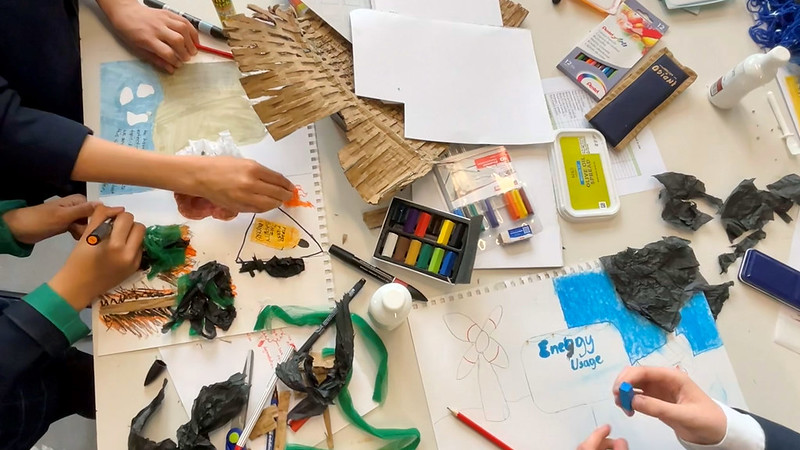It is often assumed that those with sensory impairments are unable to fully appreciate art and culture. Over time, little has been done to try and change this perception. Dr Simon Hayhoe from the Department of Education has spent the past four years conducting research into the area of inclusivity in learning technologies, training and education.
Helping European museums to become barrier-free
Since 2016, Dr Hayhoe was a partner in, and led on the analysis for, a project known as ARCHES; the Accessible Resources for Cultural and Heritage EcoSystems. Supported by the European Union, its aim is to make art and culture accessible for all, through the use of technology and participatory research. Along with the University of Bath and The Open University, several national museums and four technology companies from across Europe are involved in the research.
Dr Hayhoe made use of grounded methodology as a mode of analysis throughout the project. He created a model of ‘inclusive capital’, which outlined the habits that lead to inclusion for socially disadvantaged disabled people. This concept is introduced in his recent publication Cultural Heritage, Ageing, Disability, and Identity.
Through findings, he found that there were two diverse identities and needs amongst those with sensory impairments:
- People who develop impairments later in life
- People with early-life impairments
Dr Hayhoe noted the difference in approaches between those in each category. Those who developed impairments later in life rarely identified themselves as having the stated impairment, and often referred back to an earlier non-impaired identity and way of learning. In contrast, those with impairments present in early-life, were more likely to identify themselves according to their most significant impairment. This latter group had often been taught to believe they were incapable of understanding the arts. Hayhoe took these findings to institutions to encourage them to be aware of the diverse identities of their potential audiences.
Visual concepts can be perceived by all
A key piece of research undertaken by Dr Hayhoe aimed to interrogate Locke and Humes’s theory of colour. The findings, contrary to previous belief, demonstrated that concepts such as colour and perspective, generally understood to be solely visual in nature, can in fact, be perceived by those who are blind. Dr Hayhoe argues this is due to a combination of alternative perceptual cues, multi-sensory development, language and creative thinking. He also conducted research into the use of mobile devices by learners with disabilities, in order to stimulate debate around the role and best use of technologies.
As a result of practice and analysis in the ARCHES project, there have been some key impacts:
- Altered approaches to sensorial learning and understanding sensory impairment
- Developed a non-classificatory approach to inclusion
- Increased understanding of multi-sensorial and language experience.
Designing solutions for those with impairments
In summary, the research led to the development of several solutions designed to aid those with impairments in arts and cultural settings. These include:
- Tactile reliefs made by state-of-the-art 3D modelling techniques
- Accessible apps and games for smartphones and tablets
- Sign-language avatars
An example of the tactile reliefs used as part of the ARCHES project is the Please Touch! inclusive art experience. The ‘touch station’ is an inclusive interface challenging the traditional relationship between the viewer and a piece of artwork. Combining tactile reliefs, computer vision and multimedia clips, to allow those with impairments to experience art.
The second is a series of accessible apps that can be downloaded via Google Play or the Apple Store, designed to guide visitors through museums. Users are able to customize settings to reflect their personal needs including audio description, sign language and colour blindness requirements. Users can then read (or hear) information about the artworks in the museum, whilst following a guided route on the app. There is also the option to play an interactive game in each of the museums.
Another development, is that of a sign language avatar to be utilised within museum settings. Though in its early stages, the avatar is being further developed under the EU-supported SiMAX project.
There have been several other ‘wins’ as a result of the ARCHES project, including the installation of Wi-Fi at one partner museum, improvements to websites and the introduction of sensory backpacks.
Wider impact
Practice in ARCHES has helped in building confidence, improving access and enhancing learning for disabled people in museums. This is confirmed by sixteen of the participants in the project going on to gain awards, training or jobs in the field of cultural heritage.
In addition, the ARCHES project has achieved more than just providing a benefit to individuals with sensory impairments. Educators and artists are other key beneficiaries. Lee Campbell was mentored by Dr Hayhoe during a residency and he commented that his “mentoring… was incredibly supportive of me getting to grips with the practical realities of people who are visually impaired.”



